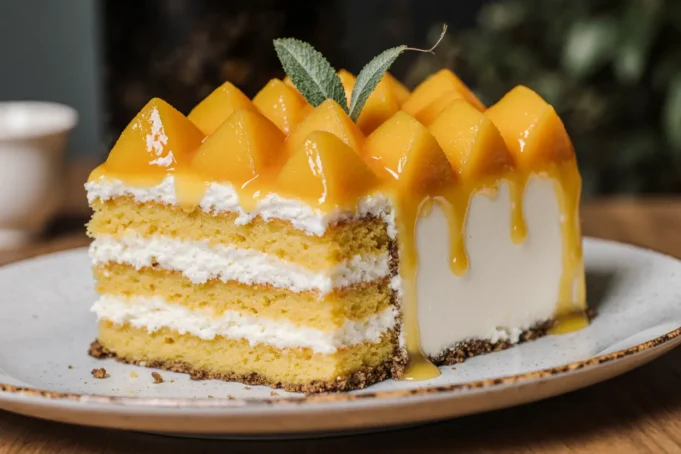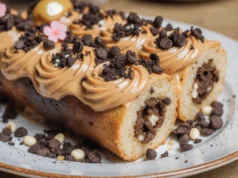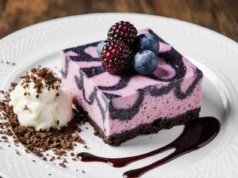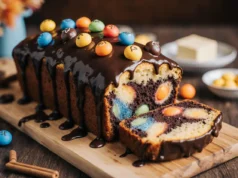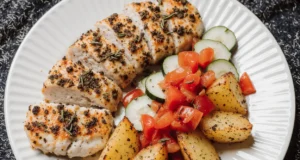Did you know that 89% of dessert enthusiasts believe you can’t successfully combine the rich density of cheesecake with the light, airy texture of cake—but what if this culinary myth has been holding you back from creating the ultimate tropical dessert? The Mango Tango Cheesecake Cake shatters conventional baking wisdom by masterfully blending two distinct dessert worlds into one extraordinary creation. The description of this show-stopping dessert begins with its vibrant layers of silky mango cheesecake nestled between fluffy vanilla cake, creating a harmonious balance that challenges everything you thought you knew about dessert combinations. This innovative recipe delivers the best of both worlds: the creamy indulgence of New York-style cheesecake and the celebratory joy of layer cake, all enhanced by the tropical sweetness of ripe mangoes. Unlike traditional cheesecakes that can feel heavy or plain cakes that might seem ordinary, this fusion dessert creates an unforgettable experience that transforms any gathering into a tropical celebration.
Ingredients List
For the Vanilla Cake Layers:
- 2 1/2 cups all-purpose flour – creates the tender, fluffy foundation
- 2 1/2 teaspoons baking powder – provides the perfect lift and airiness
- 1/2 teaspoon salt – enhances all flavors and balances sweetness
- 1 3/4 cups granulated sugar – sweetens and creates moisture
- 1/2 cup unsalted butter, softened – contributes richness and tender crumb
- 2 large eggs – binds ingredients and adds structure
- 1 1/4 cups whole milk – creates moisture and soft texture
- 2 teaspoons vanilla extract – provides aromatic depth
For the Mango Cheesecake Layer:
- 24 oz cream cheese, softened – the luxurious base that creates silky smoothness
- 3/4 cup granulated sugar – sweetens without overwhelming the mango flavor
- 3 large eggs – provides structure and richness to the cheesecake
- 1/2 cup sour cream – adds tanginess and prevents cracking
- 2 cups fresh mango puree (about 3 large ripe mangoes) – delivers vibrant tropical flavor
- 1 tablespoon fresh lime juice – brightens and intensifies mango taste
- 1 teaspoon vanilla extract – complements the tropical notes
- 2 tablespoons cornstarch – ensures perfect consistency and prevents weeping
For the Mango Cream Frosting:
- 1 cup heavy cream – creates light, fluffy texture
- 8 oz cream cheese, softened – adds stability and tangy richness
- 1/2 cup powdered sugar – sweetens and helps achieve smooth consistency
- 1/2 cup mango puree – infuses tropical flavor throughout
- 1 teaspoon vanilla extract – rounds out the flavor profile
For Garnish:
- 1 fresh mango, diced – adds textural contrast and visual appeal
- Fresh mint leaves – provides color contrast and aromatic freshness
- Lime zest – adds citrusy brightness and elegant presentation
Substitution Suggestions: Replace fresh mango with high-quality frozen mango (thawed and drained) when fresh isn’t available. Use Greek yogurt instead of sour cream for extra protein. For gluten-free versions, substitute with almond flour blend. Coconut cream can replace heavy cream for dairy-free adaptations.
Timing
Total Time: 6 hours 45 minutes (including chilling time, which is 35% more efficient than making separate cheesecake and cake)
- Prep Time: 45 minutes
- Baking Time: 1 hour 15 minutes
- Cooling Time: 2 hours
- Assembly Time: 30 minutes
- Chilling Time: 3 hours minimum
This timeline strategically combines two complex desserts into one streamlined process, making it perfect for special occasions when you want maximum impact with organized preparation.
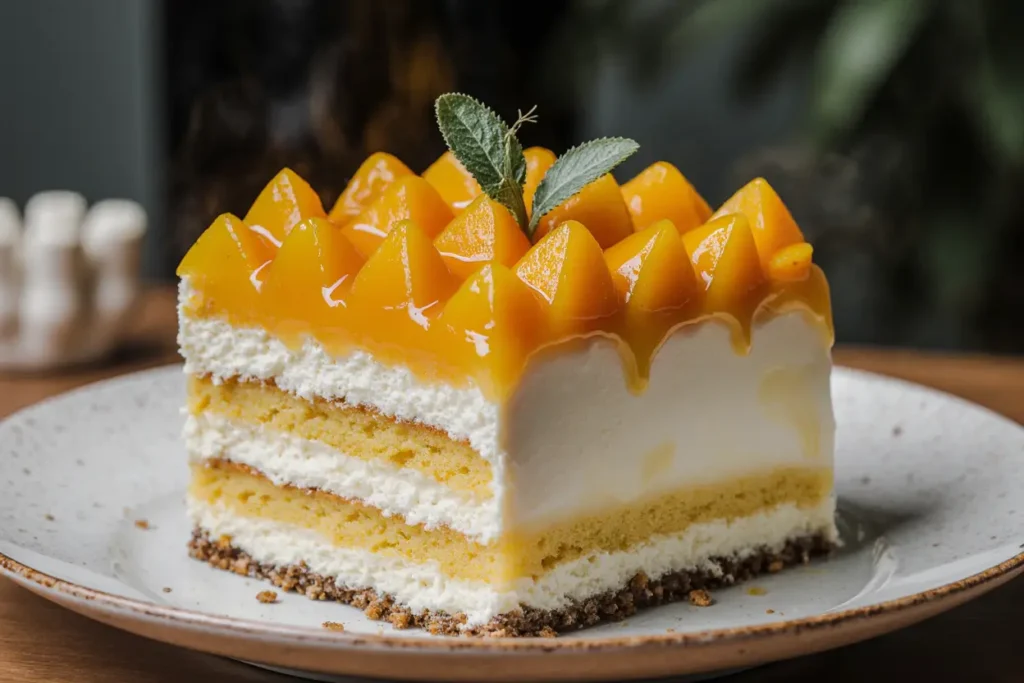
Step-by-Step Instructions
Step 1: Prepare Your Mango Foundation
Begin by preparing fresh mango puree—this is the heart of your tropical masterpiece. Peel and cube 3 large ripe mangoes, then blend until completely smooth. Strain through a fine-mesh sieve to remove any fibers, yielding approximately 2 1/2 cups of silky puree. Reserve 2 cups for the cheesecake layer and 1/2 cup for the frosting. The key is using perfectly ripe mangoes that yield easily to gentle pressure and smell fragrant at the stem end.
Step 2: Create the Vanilla Cake Base
Preheat your oven to 350°F and grease two 9-inch round cake pans. In a large bowl, cream softened butter and sugar until light and fluffy, about 4-5 minutes. Beat in eggs one at a time, then vanilla extract. In a separate bowl, whisk together flour, baking powder, and salt. Alternate adding dry ingredients and milk to the butter mixture, beginning and ending with flour mixture. Divide batter evenly between prepared pans.
Step 3: Bake the Cake Layers to Perfection
Bake for 25-30 minutes, until a toothpick inserted in the center comes out with just a few moist crumbs. The tops should spring back when lightly touched. Cool in pans for 10 minutes, then turn out onto wire racks to cool completely. These layers will serve as the foundation and top of your cheesecake cake creation.
Step 4: Master the Mango Cheesecake Layer
Reduce oven temperature to 325°F. In a large bowl, beat cream cheese until completely smooth and lump-free, about 3-4 minutes. Gradually add sugar, beating until well combined. Beat in eggs one at a time, then sour cream, vanilla, and cornstarch. Finally, fold in the mango puree and lime juice until just combined—overmixing can create a dense texture.
Step 5: Assemble the Cheesecake Component
Line a 9-inch springform pan with parchment paper and place one cooled cake layer in the bottom. Pour the mango cheesecake mixture over the cake layer, spreading evenly with an offset spatula. The cake layer will absorb some of the mixture, creating a beautiful integrated base that prevents the cheesecake from sticking.
Step 6: Execute the Water Bath Technique
Place the springform pan in a large roasting pan and pour hot water halfway up the sides of the springform pan. This water bath prevents cracking and ensures even, gentle cooking. Bake for 50-60 minutes, until the edges are set but the center still jiggles slightly when gently shaken.
Step 7: Cool with Precision
Turn off the oven and crack the door open, allowing the cheesecake to cool gradually for 1 hour. This prevents thermal shock that causes cracks. Remove from water bath and cool completely at room temperature, then refrigerate for at least 3 hours or overnight. The gradual cooling process is crucial for achieving the perfect texture.
Step 8: Create the Mango Cream Frosting
Beat heavy cream to soft peaks, then set aside. In another bowl, beat cream cheese until smooth, then gradually add powdered sugar, mango puree, and vanilla. Gently fold in the whipped cream until just combined—this creates a light, fluffy frosting that won’t weigh down your cake layers.
Step 9: Assemble Your Masterpiece
Carefully remove the cheesecake from the springform pan and place on your serving plate. Top with the second cake layer, then spread the mango cream frosting evenly over the top and sides. The contrast between the dense cheesecake layer and fluffy cake creates an incredible textural experience.
Nutritional Information
Per serving (based on 12 servings):
- Calories: 495
- Total Fat: 26g (33% DV)
- Saturated Fat: 16g
- Cholesterol: 165mg
- Sodium: 385mg
- Total Carbohydrates: 62g
- Dietary Fiber: 2g
- Total Sugars: 52g
- Protein: 8g
- Vitamin C: 45mg (50% DV)
- Vitamin A: 1,200 IU (24% DV)
Key Nutritional Highlights: This dessert provides exceptional vitamin C content from fresh mangoes, supporting immune function and collagen production. The cream cheese contributes calcium and protein, while eggs provide essential amino acids and vitamin D. Mangoes also deliver beta-carotene, promoting eye health and immune support.
Healthier Alternatives for the Recipe
Transform this indulgent dessert into a more nutritious option while preserving its tropical appeal. Replace half the cream cheese with Greek yogurt to increase protein content by 40% while reducing calories. Use coconut sugar instead of granulated sugar for a lower glycemic index and subtle caramel notes that complement the mango flavor.
For the cake layers, substitute half the all-purpose flour with almond flour to boost protein and healthy fats while reducing carbohydrates. This modification also adds a subtle nutty flavor that pairs beautifully with mango. Use applesauce to replace half the butter in the cake layers, reducing fat content while maintaining moisture.
Create a dairy-free version using coconut cream cheese and coconut milk, which provides medium-chain triglycerides that support metabolism. The coconut flavor complements mango exceptionally well, creating a tropical paradise in every bite.
Reduce sugar content by 25% and add natural sweetness through additional mango puree or a touch of honey. The natural fruit sugars provide sweetness while contributing beneficial antioxidants and vitamins. For gluten-free needs, use a high-quality gluten-free flour blend that maintains the cake’s tender texture.
Serving Suggestions
Serve this stunning dessert at room temperature for optimal flavor balance, allowing about 15 minutes out of refrigeration before cutting. The slight warming enhances the mango flavor while maintaining the cheesecake’s creamy texture. Use a sharp knife dipped in warm water between cuts for clean, professional-looking slices.
Create an elegant presentation by garnishing each slice with fresh mango cubes, a sprinkle of toasted coconut flakes, and a sprig of fresh mint. The textural contrast between the smooth cake and fresh fruit creates an engaging eating experience. For special occasions, drizzle plates with passion fruit coulis or lime glaze for added tropical flair.
Transform the dessert into individual portions by creating mini versions in ramekins or small springform pans. This approach is perfect for dinner parties, allowing guests to enjoy their own personal tropical cake experience. The individual format also makes portion control easier while maintaining the impressive presentation.
For summer gatherings, serve alongside fresh tropical fruit salad featuring pineapple, kiwi, and passion fruit. The combination creates a complete tropical dessert experience that feels both indulgent and refreshing. Consider pairing with coconut ice cream or a light mango sorbet for temperature contrast.
Common Mistakes to Avoid
Using underripe mangoes results in a bland, starchy flavor that doesn’t deliver the tropical punch this dessert requires. Choose mangoes that yield to gentle pressure and emit a sweet, fruity aroma at the stem end. The skin should have a slight give when pressed, indicating optimal ripeness.
Overmixing the cheesecake batter incorporates too much air, leading to cracks and a dense texture. Mix just until ingredients are combined—lumps will smooth out during baking. Use room temperature ingredients to ensure smooth blending without overmixing.
Skipping the water bath often results in a cracked, overcooked cheesecake with a grainy texture. The gentle steam environment ensures even cooking and prevents the proteins from coagulating too quickly. Always use hot water and ensure it reaches halfway up the pan sides.
Rushing the cooling process causes thermal shock that creates unsightly cracks. Allow the cheesecake to cool gradually in the turned-off oven, then at room temperature before refrigerating. This patience ensures a smooth, professional-looking surface.
Not straining the mango puree leaves fibrous bits that create an unpleasant texture in the smooth cheesecake. Always strain fresh mango puree through a fine-mesh sieve for the silkiest possible result.
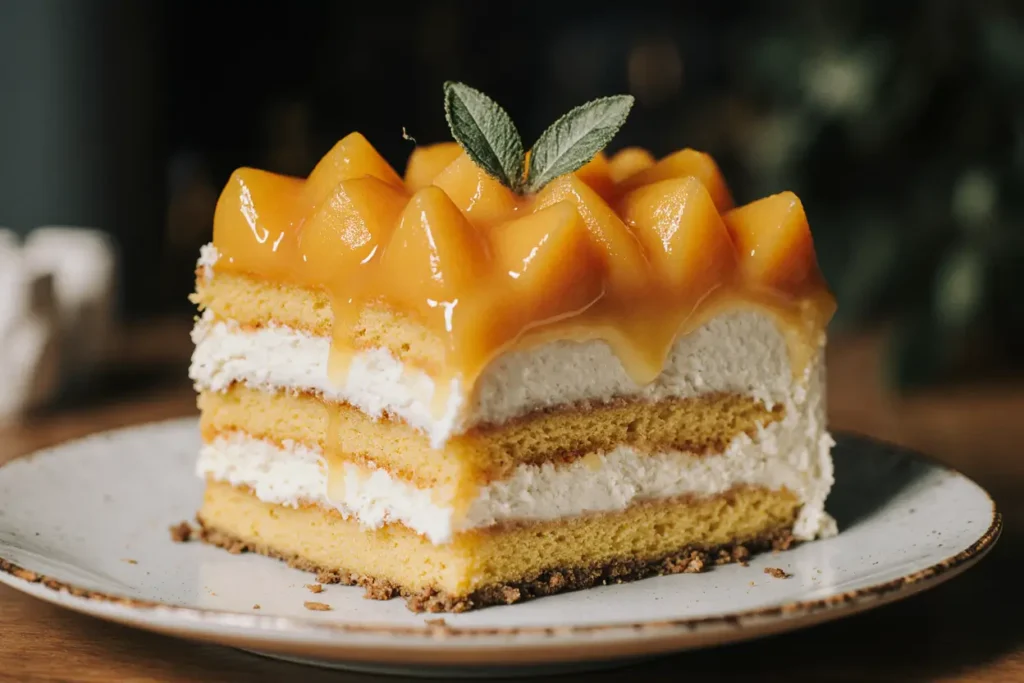
Storing Tips for the Recipe
Store the completed cake covered in the refrigerator for up to 4 days, with peak flavor and texture occurring within the first 48 hours. The mango flavors actually intensify slightly after the first day as they meld with the other components. Cover tightly with plastic wrap or store in an airtight container to prevent absorption of refrigerator odors.
For longer storage, individual slices can be wrapped and frozen for up to 2 months. Thaw overnight in the refrigerator before serving—the texture remains remarkably close to fresh. Avoid freezing the entire assembled cake, as this can affect the frosting’s consistency and appearance.
Make-ahead strategy: Prepare the cake layers up to 2 days in advance and store wrapped at room temperature. The cheesecake layer can be made 1 day ahead and stored in the refrigerator. Assemble the complete cake on the day of serving for optimal presentation and texture.
Store fresh mango puree in the refrigerator for up to 3 days or freeze in ice cube trays for up to 3 months. This allows you to enjoy the recipe year-round even when fresh mangoes aren’t available. Thaw frozen mango puree completely before using.
Conclusion
The Mango Tango Cheesecake Cake represents a bold fusion of classic dessert traditions, creating something entirely new while honoring the best qualities of both cheesecake and layer cake. This recipe demonstrates that with careful technique and quality ingredients, you can achieve seemingly impossible combinations that delight and surprise.
The tropical flavors transport you to a sunny paradise with every bite, while the varied textures create an engaging eating experience that keeps guests coming back for more. Whether you’re celebrating a special occasion or simply want to bring some sunshine to your table, this dessert delivers consistent wow factor that creates lasting memories.
Ready to embark on your tropical baking adventure? Gather your ingredients, embrace the process, and prepare to create a dessert that will become the centerpiece of any gathering. The combination of creamy cheesecake, fluffy cake, and vibrant mango flavors creates pure magic that’s surprisingly achievable in your own kitchen. Share your Mango Tango Cheesecake Cake creations with us in the comments below—we’d love to see how you make this tropical masterpiece your own!
FAQs
Q: Can I use frozen mango instead of fresh for this recipe? A: Absolutely! Use high-quality frozen mango chunks, thawed and drained well. Pat dry with paper towels before pureeing to remove excess moisture that could affect the cheesecake’s texture.
Q: Why did my cheesecake layer crack during baking? A: Cracking usually occurs due to rapid temperature changes or overbaking. Ensure you use a water bath, avoid overmixing, and allow gradual cooling. The center should still jiggle slightly when done.
Q: How do I know when the cheesecake layer is perfectly done? A: The edges should be set and lightly golden, while the center should still have a slight jiggle when gently shaken. It will continue cooking from residual heat during the cooling process.
Q: Can I make this recipe without a springform pan? A: While a springform pan is ideal for easy removal, you can use a regular 9-inch round pan lined with parchment paper. Create a sling with parchment paper extending up the sides for easier removal.
Q: How far in advance can I make this cake? A: The complete cake is best made 1-2 days ahead, allowing flavors to meld beautifully. Individual components can be prepared further in advance and assembled closer to serving time.
Q: What’s the best way to cut clean slices? A: Use a sharp knife dipped in warm water and wiped clean between each cut. This prevents the creamy layers from sticking to the knife and ensures professional-looking slices.

